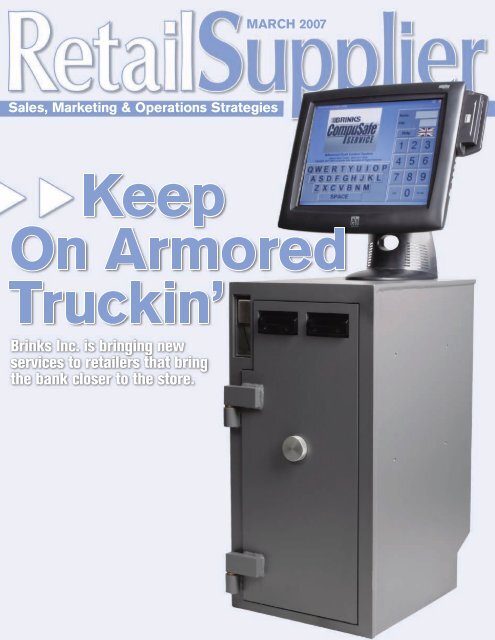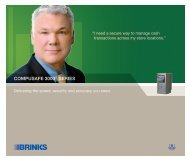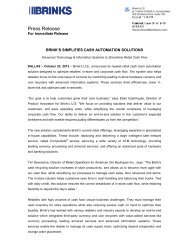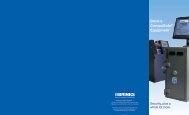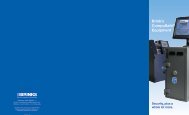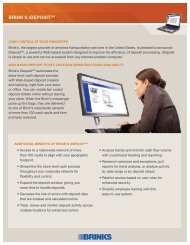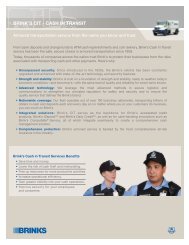Sales, Marketing & Operations Strategies - Brink's US
Sales, Marketing & Operations Strategies - Brink's US
Sales, Marketing & Operations Strategies - Brink's US
Create successful ePaper yourself
Turn your PDF publications into a flip-book with our unique Google optimized e-Paper software.
<strong>Sales</strong>, <strong>Marketing</strong> & <strong>Operations</strong> <strong>Strategies</strong><br />
MARCH 2007
COVER STORY<br />
Keep On Armored<br />
Truckin’<br />
Brink’s, Incorporated is bringing new services to<br />
retailers that bring the bank closer to the store.<br />
Top management at Brink’s, Incorporated is focusing<br />
not at the company’s last 150 years but its next 150,<br />
with ground-breaking initiatives that include cuttingedge<br />
technologies and precedent-shattering partnerships.<br />
A subsidiary of The Brink’s Company, Brink’s,<br />
Incorporated is a global leader in business and security<br />
services, delivering customized secure logistics solutions to<br />
help companies manage their cash supply chain. Brink’s<br />
offers transportation, secure currency and coin processing,<br />
inventory management, document destruction and cash<br />
management solutions.<br />
The firm, headquartered in the U.S. in Coppell, TX, also<br />
markets a full range of secure logistics solutions and technologies,<br />
including cash processing, ATM services, web information<br />
tools, cash in transit and the Brink’s CompuSafe ®<br />
Family of Services. Brink’s is the largest armored car company<br />
in the U.S., operating over 250 branches and 2,300 armored<br />
vehicles across the nation. It is also the largest provider of<br />
coin-processing services.<br />
Since Brink’s retail solutions combine secure transportation<br />
with cash management services, they can provide<br />
retailers with accelerated funds availability, streamlined<br />
operational processes, and visibility and control over<br />
cash handling.<br />
PAST AND FUTURE<br />
The company has a rich heritage of innovation:<br />
• It introduced its CompuSafe Service in 1998 as the industry’s<br />
first closed-loop cash management system for cashintensive<br />
retail businesses. CompuSafe is a cash-handling<br />
solution that takes cash out of retailers’ hands. Cashiers<br />
simply insert currency into one of the Brink’s CompuSafe<br />
intelligent safes, where it is securely stored until a Brink’s<br />
armed guard or armored truck picks it up and takes it to a<br />
Brink’s vault facility for processing and deposit. The service<br />
limits the amount of cash in registers, as well as on-site<br />
counting and recounting of cash.<br />
• In 2004, Brink’s pioneered The Brink’s iCash system, a
sophisticated cash vault<br />
processing system based<br />
on central database technology.<br />
• Brink’s iDeposit, a webbased<br />
deposit-creation<br />
and tracking tool, eliminates<br />
manual deposit<br />
preparation and paper<br />
tickets for improved productivity,<br />
efficiency, and<br />
accuracy. The system<br />
combines armored<br />
transportation with technology-based<br />
information<br />
tools to create a cash<br />
management solution<br />
that increases efficiencies,<br />
expedites funds<br />
availability and improves<br />
cash flow. Users simply<br />
input deposit amounts<br />
by denomination, print<br />
the automatically generated<br />
deposit ticket, and<br />
seal the ticket inside a<br />
tamper-evident bag<br />
along with the cash. The<br />
system can be accessed<br />
from any phone or<br />
Internet-enabled computer,<br />
with no software<br />
to install or buy.<br />
A TIME OF CHANGE<br />
The past year was a “very<br />
good” one for Brink’s,<br />
Incorporated, says Fred<br />
Purches, the company’s<br />
senior vice president for<br />
strategic solutions and product management. It was also a<br />
time of continued change.<br />
“There are a lot of changes going on in the industry, and<br />
I’m referring to the industry that typically handles retailers’<br />
cash,” he notes. Those changes involve banks, armored car<br />
companies and checks. Together, says Purches, they “are creating<br />
a lot of opportunities for retailers to save money in the<br />
way that they handle cash.”<br />
“One of the things that is happening, and which retailers<br />
have begun taking good advantage of, is that banks are<br />
starting to expand their footprint through so-called virtual<br />
vaults,” says Purches.<br />
The term “virtual vault” is actually a bit of a misnomer.<br />
Banks traditionally operate<br />
their own cash vaults. With<br />
“virtual vaults” they establish<br />
relationships with<br />
armored carriers to run<br />
vaults for them outside of<br />
their normal footprint.<br />
This is important to<br />
retailers because it allows<br />
them to consolidate their<br />
banking relationships.<br />
Larger retailers operating<br />
across several regions may<br />
maintain as many as 250 or<br />
300 banking relationships<br />
because they use whichever<br />
bank is located closest to<br />
their outlets. The growth of<br />
virtual vaults allows them<br />
to consolidate that number<br />
down to as few as five—or<br />
fewer—relationships.<br />
Another trend that continued<br />
to evolve throughout<br />
2006, Purches says,<br />
involves the way checks are<br />
handled. Legislation<br />
passed in 2005 allows<br />
checks to be imaged.<br />
“Some of the benefits of<br />
that also started to make<br />
themselves available to<br />
retailers during 2006,” says<br />
Purches, “and that will continue<br />
in 2007.”<br />
TECHNOLOGY AND<br />
PARTNERSHIPS<br />
Brink’s strategy this year is<br />
to use technology—and to<br />
develop partnerships with other suppliers—that can help to<br />
make cash- and check-handling more efficient. For one<br />
thing, armored car carriers in general, and Brink’s in particular,<br />
are developing partnerships with banks.<br />
“In the past, you would have armored carrier selling you<br />
transportation and the bank selling you depository services or<br />
bank accounts,” Purches says. “Now you have armored carriers<br />
and banks coming together in selling better solutions.”<br />
One of them, unique to Brink’s, is the Brink’s iDeposit,<br />
which he describes as “essentially an online deposit ticket.”<br />
Store managers use it like this: a store logs into Brink’s computer<br />
system and fills out a deposit slip: how many singles,<br />
fives, tens, etc. When they submit that deposit slip, the sys-
BRINK’S, INCORPORATED<br />
<br />
tem notes the date and<br />
time that it was created,<br />
and prints out an 8.5-<br />
by-11-inch piece of<br />
paper which is essentially<br />
a bar-coded<br />
deposit slip. The retailer<br />
includes it with his normal<br />
deposit, and a<br />
Brink’s truck will collect<br />
it along with its regular<br />
pick up. The barcode is scanned back at the Brink’s facility,<br />
again noting the amount, date and time, and the money gets<br />
processed.<br />
“The interesting thing is that we have partner banks that<br />
are crediting customer accounts on a same-day basis,” says<br />
Purches. “The traditional methodology is that the retailer<br />
would get credit for that money the next day—the day after it<br />
was picked up.” This system allows them to get credit the<br />
same day cash is picked up, and lends a greater degree of<br />
transparency to deposits.<br />
“They can look at all their stores, see the date and time that<br />
a deposit was created, what time they got to the vault, what<br />
time they were processed, and if there were any discrepancies,”<br />
Purches says. “For example, if the store said there was<br />
Industry changes “are<br />
creating a lot of opportunities<br />
for retailers to<br />
save money in the way<br />
that they handle cash.”<br />
$1,000 but there was really<br />
only $500 when we<br />
counted it, they would<br />
be able to see that pretty<br />
quickly.”<br />
The procedure essentially<br />
gives a retailer a<br />
real-time view of his<br />
deposit process and<br />
immediate red flags in<br />
case of discrepancies.<br />
“It’s the best of both worlds,” says Purches. “It lends visibility<br />
to things, but it also gives them quicker credit.”<br />
Brink’s is also doing exciting things with its CompuSafe<br />
product, which was originally designed for the convenience<br />
store market. “That is an environment with high turnover<br />
and high theft rates,” says Purches. “The way they handle<br />
cash in the convenience store traditionally is: every time the<br />
register gets over ‘X amount,’ say $100, they will take the<br />
extra cash and put a paper clip around it with a piece of<br />
paper that says, ‘Fred dropped $60,’ and they will put it in a<br />
safe. At the end of the day, or the next day, the manager<br />
opens up the safe, takes out all of those envelopes, goes in<br />
the back room and counts them. The manager spends a lot<br />
of time doing that, and there can be complications such as<br />
— Fred Purches, svp, strategic solutions and product management
COVER STORY<br />
BRINK’S, INCORPORATED <br />
discrepancies that can take hours to resolve.”<br />
CompuSafe “is essentially a safe with two bill acceptors<br />
in it, just like you would find in a vending machine,”<br />
Purches explains. “Instead of the paper and the paper clip,<br />
the clerk can take the money and simply stick it into one of<br />
those bill acceptors.” The acceptors read, count and stack<br />
the bills in locked cassettes. Brink’s personnel pick up the<br />
money for processing and deposit it in their bank. The contents<br />
of the safe are guaranteed. “So essentially as soon as<br />
they put that money in their safe they don’t have to worry<br />
about it anymore.”<br />
A new version, called CompuSafe 4000, serves as a<br />
high-volume bill acceptor, taking as many as 150 notes<br />
at a time, which are fed in stacks. “It’s the same principle,<br />
it just works in a different environment,” says<br />
Purches. The unit is designed for supermarkets and<br />
other high-volume retailers.<br />
CompuSafe 4000 utilizes a heavy-duty safe with an easyto-use<br />
touch-screen interface to read and verify 16 bills per<br />
second. It interfaces seamlessly with POS and back-office<br />
systems to automate the cash-handling process and virtually<br />
eliminate exposure to theft and shrinkage.<br />
BANKING ON CHANGE<br />
Brink’s has also updated the way it works with banks. “Traditionally<br />
in a CompuSafe you pick up every other day and the<br />
credit for that money will follow the day after we picked up,”<br />
says Purches. Some of the banks that are now partnering with<br />
Brink’s will credit customer accounts based on the money in<br />
the safe at the end of a day.<br />
“If you think that through,” he explains, “what you have done<br />
is essentially moved the bank into the store. The retailer puts<br />
the money in the safe, and at the end of the day that money<br />
shows up on their bank statement. Then we come by and we<br />
will pick it up, take it back to our facilities and process it. That’s<br />
an exciting and interesting product for us.”<br />
Yet another new initiative from Brink’s involves a strategic<br />
alliance with “a major shipping company,” says<br />
Purches. The new service, which is scheduled to be officially<br />
launched later this year, will allow Brink’s to ship limited<br />
amounts of cash—less than $5,000—through the shipper’s<br />
network. Brink’s maintains an operation at the potential<br />
partner’s consolidation point.<br />
“One of the challenges…is for retailers to justify the cost of<br />
an armored transportation service,” says Purches. “This is kind<br />
of a middle-of-the-road solution: it is less expensive than an<br />
armored car but still allows the retailer the benefit of their store<br />
managers not having to travel to the bank and the time and<br />
risk associated with doing that.”<br />
Also, it allows them to consolidate their banking relationships.<br />
They can, Purches notes, “essentially have one<br />
bank account at the end of the day, and there is technology<br />
that is bundled around that, too: the same kind of concept<br />
we talked about with Brink’s iDeposit, where they can<br />
see it tracking through that process.”<br />
There is, Purches re-emphasizes, “a lot of change going on in<br />
the industry right now. We have historically taken the approach<br />
that we want to do everything ourselves. One of the things that<br />
changed is that we are now recognizing that we can’t do everything.<br />
We need to select the first-rate partners that have expertise<br />
in different places, and then develop products in conjunction<br />
with them. The banks and the shipping company are<br />
examples of that, as are the safes. We used to make those ourselves,<br />
but now we have manufacturing partners.”<br />
Such strategic alliances will almost certainly prove to be<br />
the key to addressing still larger changes on the road ahead.<br />
(#13958) Reprinted from the March 2007 issue of Retail Supplier. Copyright 2007 Ideal Media.<br />
For more information about reprints from Retail Supplier, contact PARS International Corp. at 212-221-9595.


